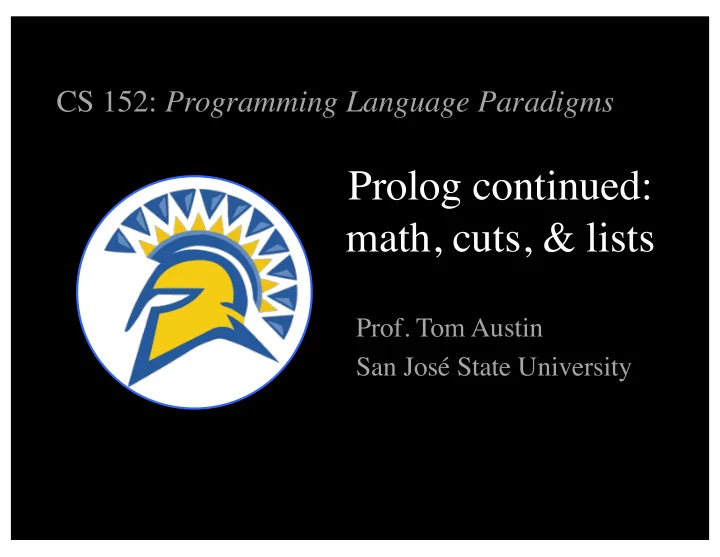

CS 152: Programming Language Paradigms Prolog continued: math, cuts, & lists Prof. Tom Austin San José State University
Review murder mystery lab (in-class)
Math in Prolog
Arithmetic in Prolog heists(joker, 97). heists(penguin, 18). heists(catwoman, 31). heists(scarecrow, 42). combined_heists(X, Y, Total) :- heists(X,XN), heists(Y,YN), Total = XN + YN.
?- combined_heists(catwoman, scarecrow, T). T = 31+42.
Using "is" operator combined_heists(X, Y, Total) :- heists(X,XN), heists(Y,YN), Total is XN + YN. ... ?- combined_heists(catwoman, scarecrow, T). T = 73.
The Cut Operator "Learn Prolog Now" section 10.2
The Cut Operator Motivation: • Prolog may needlessly backtrack • We wish to stop the backtracking to optimize our code.
max example (no cuts) max(X,Y,Y):- X =< Y. max(X,Y,X):- X > Y.
Using max ?- max(2,3,M). M = 3 ; Why continue the search? false. ?- max(2,1,M). M = 2.
Two types of cuts ( ! ) • A green cut – improves performance or memory usage – Does not alter results • A red cut – controls resolution to prevent future matches – changes the results – is considered "bad form"
max example (no cuts) max(X,Y,Y):- X =< Y. max(X,Y,X):- X > Y. If true, no need to keep searching
max example, with green cut max(X,Y,Y):- X =< Y, ! . max(X,Y,X):- X > Y. Last rule, so no cut needed.
Red Cut Example Batman is enemies with all villains, unless the villain is also a romantic interest.
Red Cut Example enemy(batman, X) :- romantic_interest(X), ! , No backtracking once fail. we make it here. enemy(batman, X) :- villain(X).
Red Cut Example bad_breakup(batman, talia). bad_breakup(batman, poison_ivy). enemy(batman, X) :- romantic_interest(X), ! , bad_breakup(batman, X) . enemy(batman, X) :- villain(X).
Avoiding red cut bad_breakup(batman, talia). bad_breakup(batman, poison_ivy). enemy(batman, X) :- villain(X), \+ romantic_interest(X). enemy(batman, X) :- villain(X), bad_breakup(batman,X). Alternate syntax for not
Lists in Prolog
List • Syntax for head/tail: [Head|Tail] • Syntax for multiple elements [1,2,3,4] • Prolog list solutions are often recursive.
myappend % Base case myappend([], L2, L2). % Recursive case myappend([H|T1],L2,[H|T2]) :- myappend(T1, L2, T2).
Using myappend ?-
Using myappend ?- myappend([1,2], [3,4], Result). Result = [1, 2, 3, 4]. ?-
Using myappend ?- myappend([1,2], [3,4], Result). Result = [1, 2, 3, 4]. ?- myappend([1,2], [3,4], [1,2,3,4]). true. ?-
Using myappend ?- myappend([1,2], [3,4], Result). Result = [1, 2, 3, 4]. ?- myappend([1,2], [3,4], [1,2,3,4]). true. ?- myappend(Prefix, [3,4], [1,2,3,4]). Prefix = [1, 2] ; false. ?-
myreverse myreverse([], []). myreverse([H|T], L) :- myreverse(T, RT), append(RT, [H], L).
in_list & quicksort (in-class)
graph.prolog facts edge(a, b, 2). 4 edge(b, a, 2). F A edge(a, c, 3). 2 edge(c, a, 3). 3 B 2 edge(a, f, 4). 5 1 edge(f, a, 4). C E edge(b, c, 2). 3 edge(c, b, 2). D edge(c, d, 3). edge(d, c, 3). edge(c, e, 1). edge(e, c, 1). edge(d, f, 5). edge(f, d, 5).
graph.prolog rules find_path(Start, End, Cost, Path) :- edge(Start, End, Cost), Path = [Start, End]. find_path(Start,End,TotalCost,Path) :- edge(Start, X, InitCost), find_path(X,End,RestCost,TailPath), TotalCost is InitCost + RestCost, Path = [Start|TailPath].
Debugging Prolog ?- find_path(a, c, TC, P). TC = 3, P = [a, c] ; TC = 4, P = [a, b, c] ; TC = 7, P = [a, b, a, c] ; TC = 8, P = [a, b, a, b, c] ; TC = 11, P = [a, b, a, b, a, c] ; TC = 12, P = [a, b, a, b, a, b, c]
Debugging Prolog • To walk through Prolog's steps: ?- trace. true. • Run your queries normally, hitting enter to step forward • To stop tracing: ?- notrace. true. • <Example in class>
Lab: Graph Fix graph.prolog to avoid retracing steps. Add a Visited variable to find_path . Initially, Visited is an empty list. At each step, add the current node. Do not try a node if it has been visited.
Batman, scary villains redux (in-class)
Homework • Airline reservation system. • Sample fact: flight(sfo,lax,8:00,9:20,86.31). • Details in Canvas.
Recommend
More recommend